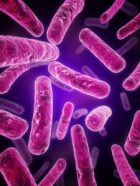Life in the bacterial underground
Tiny life forms in rock may coax minerals to release hydrogen for food
To you, a rock is just a rock — something you can study, or climb, or throw into a pond. But to bacteria and other tiny organisms that live deep underground, rocks and minerals may offer something extra: The energy for staying alive.

Microscopic organisms, often called microbes, are so small you can usually see them only under the microscope. Microbes living in rock beneath Earth’s surface seem to be able to secure their own food. When microbes are mixed with ground-up minerals and heated, the minerals produce hydrogen, say the scientists behind a recent study. The microbes eat the hydrogen and stay alive. When the microbes aren’t around, the minerals produce barely any hydrogen.
The bacteria appear to help get the hydrogen, R. John Parkes told Science News. Parkes, a geomicrobiologist at Cardiff University in Wales, led the new study of microbes and minerals.
Geologists study rocks to understand how Earth has changed and is changing, and microbiologists study very small life forms. Geomicrobiologists are part Earth scientists, part life scientists. They study how microbial life interacts with rocks and minerals, as when microbes live deep underground.
In the last few decades, scientists have had to change the way they think about how microbes live on and beneath Earth’s surface. It turns out that microbes have been discovered living in harsh underground environments, where the heat and pressure would quickly extinguish human life.
Scientists now estimate that twice as many microbes live underground than live on the surface or close to it. Parkes’ study may answer questions about how life can get energy and exist miles underground, where the Sun doesn’t shine. Without sunlight, organisms cannot use photosynthesis to produce food, so they must feed some other way.
Parkes says other planets may have similar underground environments ― so if scientists do find alien life, they might not be able to see it until they dig deep.
Earlier experiments have shown that microbes living deep underground feed on organic matter that settles on the ocean floor. Organic matter comes from organisms that used to be alive, including plants and animals. But for their experiment, Parkes and his colleagues decided to see whether inorganic matter — stuff that was never alive, such as minerals — could also provide fuel.
The researchers first ground up minerals, like quartz and basalt, and mixed in some organic matter. Into some samples, they also added microbes. The mixtures were heated, and those that contained microbes began producing hydrogen as the temperature climbed. The mixtures without microbes, which had been sterilized to kill any living things that might have snuck in, produced very little hydrogen. That suggests that the minerals couldn’t make hydrogen unless some microbes were hanging out.
Steven D’Hondt, who did not work on the study, told Science News the results were “curious but not compelling,” which means he’s not yet convinced that hydrogen came from the minerals. D’Hondt is an oceanographer (scientist who studies the oceans) and geobiologist at the University of Rhode Island in Narragansett. He says further experiments are needed to make sure the hydrogen is coming from the minerals, rather than from the organic matter in the mixture.
POWER WORDS
(adapted from the Yahoo! Kids Dictionary)
microbiology The study of microorganisms and how they interact with and affect other living organisms.
geomicrobiology The study of how microorganisms use rocks and minerals. Also, the study of rocks to find evidence of details of past microscopic life and past environments.
oceanography The scientific study of the ocean.
microbe A very small life form; a microorganism.
hydrogen The lightest and the most abundant element in the universe.
element All matter on Earth is made of elements. Elements are the most basic substances on Earth. They can’t be broken down into simpler substances without changing into something else.







